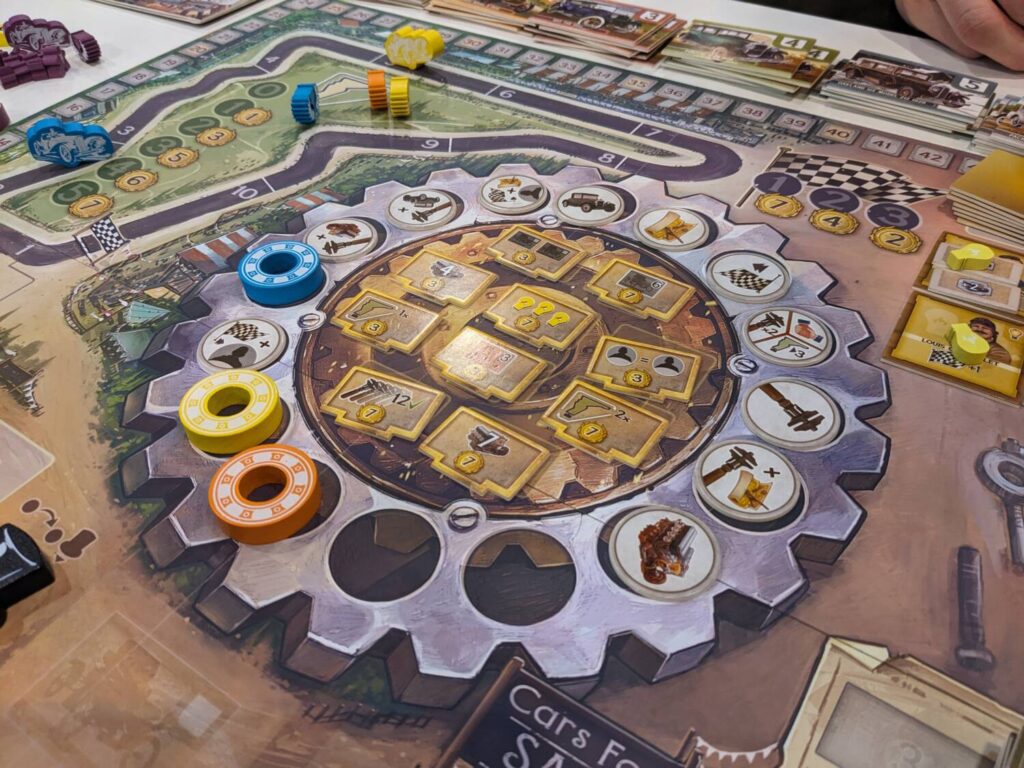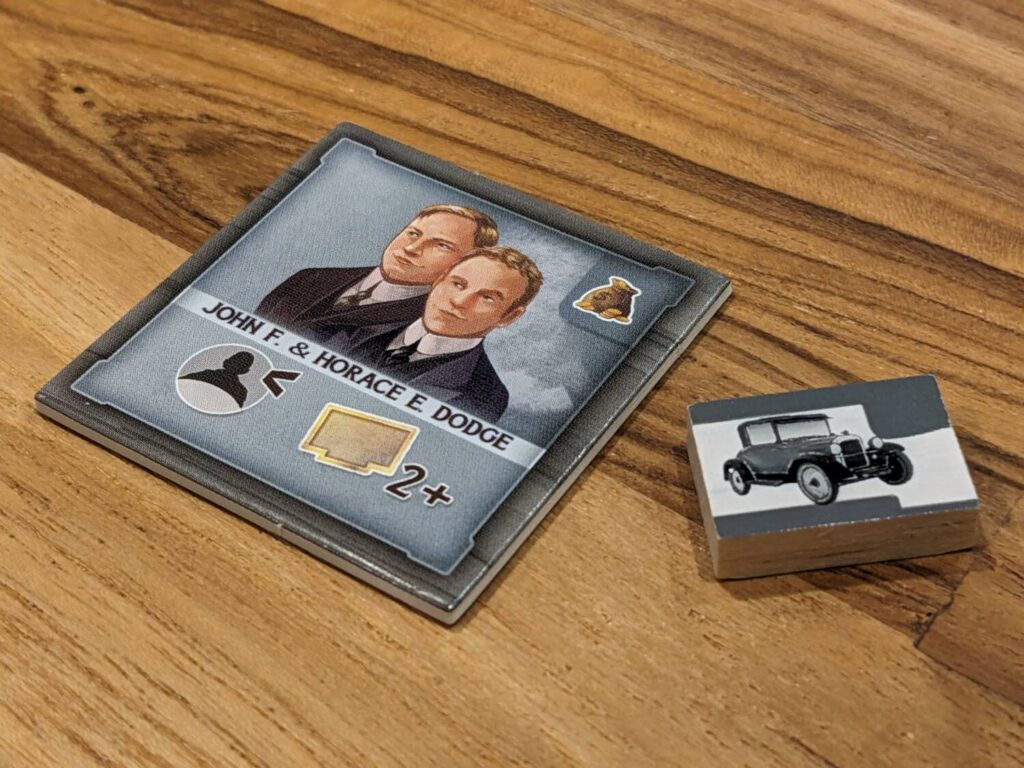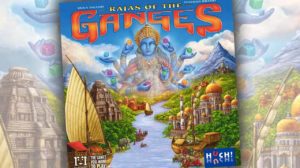Disclosure: Meeple Mountain received a free copy of this product in exchange for an honest, unbiased review. This review is not intended to be an endorsement.
I stopped by the Arcane Wonders booth at SPIEL 2024 to check out the new game Kraftwagen: Age of Engineering. I was excited about it from the get-go: the cover art looked great, and the box offered one additional stand-out detail—the name of the designer, Matthias Cramer.
That’s because Cramer designed Glen More II: Chronicles, one of my all-time favorite games. While other games use a rondel mechanism to dictate turn order, I think Glen More II does rondels better than any other game I have tried. The combination of Cramer’s name here mixed with the fact that Kraftwagen: Age of Engineering is also a rondel game had me pre-sold on the idea that this would be worth a look.
The new version is based on Cramer’s original game, Kraftwagen, published back in 2015. While I have not played the previous game, two other people in my network had, and both indicated that while that first game was pretty good, there were some elements that rubbed them, as hardcore strategy players, the wrong way.
One of those two people, my buddy John (he of the Dusty Euros series), joined me for a demo of the new Kraftwagen at SPIEL to see how it played. And after our three-player demo game, John and I both agreed Kraftwagen: Age of Engineering is great, but highly dependent on the player count.

Studebaker, Baby
Kraftwagen: Age of Engineering is a 2-4 player rondel action selection game. It’s the early 20th century, and players assume the role of automotive start-ups tasked with designing and testing new cars that will later be brought to market to score reputation points. At the end of three rounds, the player with the most reputation points will be declared the victor.
One of the signs that this game was designed a thousand years ago is that there are no wacky, multilayered end-game scoring mechanics. The score earned during the game’s three rounds are all the points. No private milestones, no complicated resource-for-points conversions. The game just ends. This lack of additional end-game scoring actually confused one of the players who joined me for my review plays, because we are used to playing so many complicated Euros!
Kraftwagen’s streamlined approach to in-game scoring is great, too. Turns are driven by a central rondel, where the player furthest behind on a circular action track is the active player and can choose any of the 11 actions on the wheel. Of course, this also means that when a player takes an action that is a lot farther ahead on the wheel that they may have to wait a while before taking another turn.
Most actions are straightforward: players can increase their research in either car bodies (chassis) or engines, hire workers that can later work as sales staff for your vehicles, take a car body or an engine into your Workshop (player board storage spaces), or move their race car around a small test track in the upper left-hand portion of the board. There are also one-time, ongoing, and investor powers that can be acquired through the Recruitment action.

A few of the actions simply combine these base actions—some allow for the hiring of a worker and getting a new car body, for example. One action lets you do three actions—research a tech, race your test car, and add a buyer to the market. Buyers come into play at the end of each round. Players will collectively build up a market of cars for sale—combining at least one worker, a car body, and an engine from their player board—and there are six spaces for cars. When a player puts a car up for sale, they also have to determine the price they want to place on their new car from a pool of eight different prices.
The price will pay out as reputation points, but figuring out a price that will ensure the car sells is maybe my favorite part of the Kraftwagen design. That’s because there might be six cars on the market, but a maximum of four buyers are slotted into the market each round. And, the round end triggers when either six cars enter the market or four buyers are placed before a short countdown begins to offer players a chance to close out their affairs.
Investor tiles—added through the Recruitment action defined earlier—can be added to the buyer pool, but in my experience across three review plays (once at three players, twice at four players), there were never enough buyers plus investors to ensure all cars on the market sold. Buyers and investors come into the sales process with an agenda. Some want to buy the nicest car body, others want to buy a car with the cheapest price, so putting buyers and investors into the market to ensure your car sells is such a fun series of mini-games to play against your opponents.
So, half the round’s scoring comes from the car-selling process, with any unsold cars getting dumped into the river. The other half comes from speeding around the test track, with the best test car scoring seven points plus a bonus tied to the number of laps that player made around the track. That meant the test track was not the best way to score points, but it was vital in every play. I pushed hard to sell at least one car, ideally two, every round, and finish at least second on the test track each time to add a few reputation points to the final score.

Easy to Learn, Difficult to Master, Fast to Finish
Kraftwagen: Age of Engineering was a lot of fun, and Cramer’s designs (including both Glen More II and Rococo, a game I always enjoyed greatly) continue to land well for me. The limited edition copy of Kraftwagen: Age of Engineering provided by the publisher is a mostly snazzy-looking production, with upgraded buyer, action, and milestone tokens to make the whole thing stand out. (One strange choice was made with the race car, though. The car meeple just doesn’t look right. It is a screen-printed picture of a car drawn from a side view, but when standing it up, it doesn’t sit flat on the board, leading every single person who joined me at the table to comment about how weird it looked.)
Kraftwagen: Age of Engineering is an easy game to teach, and the back of the rulebook answers any questions for players about the basic actions. (The ongoing power tiles, known as Engineering tiles, and the other tiles that can be acquired through the Recruitment action are defined in the rulebook appendices, but we found that once players heard about the powers of the six tiles in that market to begin a round, we didn’t need to reference it a second time.)
Playtime? Oh my goodness, Kraftwagen was beautiful…my longest game lasted 90 minutes (four players). My other four-player game wrapped in 70 minutes, and the three-player game finished in under an hour. You can definitely teach, then play Kraftwagen in about 90 minutes, even with more deliberate players, because the actions are so straightforward.

Kraftwagen: Age of Engineering at four players is probably a 4.5 out of 5.0 for me. But I already know the game would take a significant hit at two players, because even at three players, the game was notably less interesting. The car market doesn’t fill up the same way with fewer players. Also, to simulate a four-player game, two of the out-of-play race cars take up spaces three and six on the test track, to ensure that players can complete laps as quickly as they can in a four-player game.
(The game’s ruleset forces players to skip occupied track spaces, meaning in a four-player game, three of the track’s ten spaces might be occupied by opponents. Flying around the track with an upgraded race car is really easy to do, which means higher scores for the lap bonus at the end of a round.)
In this way, Kraftwagen is almost worse as a three-player game than a two- or four-player game! Because it is so hard to market a game as a four-player-only game, I’m sure Kraftwagen was never going to be labeled that way. Still, you want to play Kraftwagen as a four-player-only game. Trust me!
One other minor ding: the number and variety of public achievements that can be scored during play are always the same ten tiles. Ditto for the other Recruitment tiles. There’s only eight different Investors, for example, so you are going to see everything the game has to offer by your third or fourth play.
That doesn’t mean the game is bad, by any means. It just means this is a game that works better as a “break this out a couple times a year” product than a game your play group tables on a weekly or monthly basis.
Kraftwagen: Age of Engineering is a good time. I’m excited to keep this one in my collection!












Add Comment